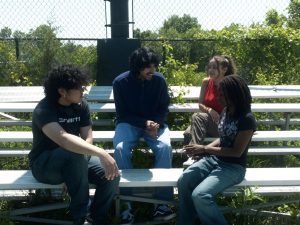The Importance of PE & Health Class
December 1, 2020
Do you count all the calories you consume in a day?
The answer is probably “no” for the majority of the kids in the U.S. as most may not even know what a calorie is.
“A calorie is a unit of energy,” says Mary L. Gavin in her article “Learning About Calories.” Your body needs calories for energy, but eating too many calories — and not burning enough of them off through activity — can lead to weight gain.
Kids consume extra calories throughout their day by eating more junk food than needed, and definitely, more than is recommended. Educationandbehavior.com, a website founded by a certified school psychologist and licensed behavior specialist, notes that “physical education at school helps in preventing obesity and high blood pressure. Physical exercise and activities will help them burn off their extra calories. If these calories are not burned off they will be stored as fat.”
Writer Ray Sam of Educationandbehavior.com also notes that “while muscle strengthening exercises make muscles larger and stronger, they also help children carry more weight and aid in protecting joints against injuries. ”
“While approximately 90 percent of U.S. children are born healthy, the United States is ranked last out of 21 industrialized countries in overall child health and safety,” reports the American Cancer Society in the report “Health Education in Schools – The Importance of Establishing Healthy Behaviors in our Nation’s Youth.” This is not something we need to live with, however. This lack of child health and safety can be improved through several factors, including physical education and health classes.
According to the same report from the Cancer Society, “One critical problem is our growing, nationwide obesity crisis…” which is an issue that the nation has need to address for years. In fact, “approximately two-thirds of the U.S. adult population is now estimated to be overweight or obese.”
One of the major issues related to obesity is that it often begins in childhood. The article “25 Childhood Habits That Affect Your Adult Health” by Morgan Greenwald, reports that, “the Centers for Disease Control and Prevention (CDC) warns that obese children are more likely to grow up to become obese adults with health conditions.”
As both of these reports show, being overweight – especially at a young age – can carry on when you’re older and it can cause significant health problems like heart disease, type 2 diabetes, and certain types of cancer. The way to fix this issue starts with our school systems.
Montgomery County Public Schools requires that all students have at least one credit (1 year ) of physical education and .5 credit of health class in high school. Both Howard County and Prince George’s County (PG) require that students have at least half a credit (.5) in both P.E and Health class. This is too low a standard for students to fully understand all the benefits of P.E and Health class.
When one looks at all of the evidence regarding the health of individuals in the United States, it is clear that more needs to be done to improve overall health. And this can begin with schools requiring more physical and health education. Having the extra time to exercise or examine good health in a child’s school day will greatly benefit them in the long run.
We need to double the amount of physical education and health class required. Howard and Prince Georges County’s standards are way too low for the student’s good, and even though MCPS has a higher requirement than PG and Howard county it’s still not good enough. All three counties should have students take a minimum of two years of P.E class and one year of Health class. Preferably for Health class take one semester in 10th grade and the second semester in 12th grade.
All schools, including MCPS, PG, and Howard County, should all have students take two years of PE and one year of Health class because it will give them the knowledge of how to keep their body healthy when becoming an adult.












































